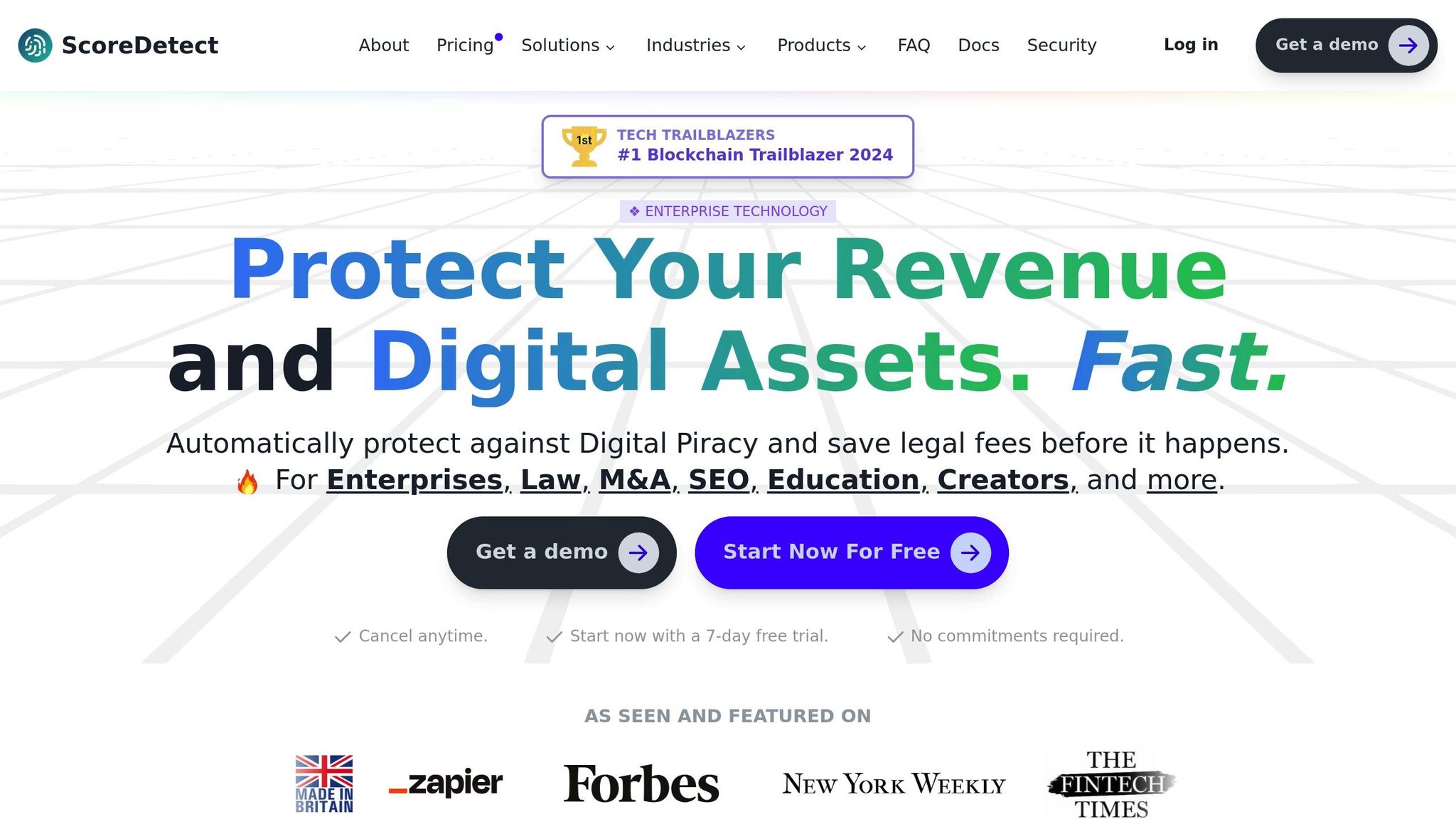Digital watermarking is a method of embedding ownership details directly into digital files like images, videos, audio, and documents. Unlike traditional copyright notices or metadata, these watermarks are integrated into the file’s structure, making them difficult to remove or alter. They serve as proof of ownership, help track content usage, and reduce risks like piracy and misuse. This technology is widely used across industries, from photography to legal documentation, to protect intellectual property and streamline copyright enforcement.
Key Takeaways:
- What It Does: Embeds ownership details into files, visible or invisible.
- Why It Matters: Protects content, helps prove ownership in disputes, and prevents misuse.
- Who Uses It: Creators, businesses, governments, and researchers across various fields.
- How It Works: Alters file structure subtly to embed data, resistant to edits or compression.
- Advanced Tools: Platforms like ScoreDetect use blockchain and AI for enhanced protection.
By integrating watermarking into workflows, content creators and organizations can safeguard their assets, reduce legal risks, and maintain control over their work.
What Is Copyright Protection With Digital Watermarking? – SecurityFirstCorp.com
How Digital Watermarking Works
Digital watermarking works by subtly altering the structure of a digital file to embed information like copyright details or ownership data. These changes are so minor that they’re invisible to the human eye or ear but strong enough to withstand common file manipulations such as compression, resizing, or format conversion.
Here’s how it works: First, an algorithm analyzes the file to pinpoint the best areas for embedding the watermark. For images, this might mean tweaking pixel values in spots where the changes won’t be noticeable. For audio files, frequencies outside the range of human hearing are adjusted. Once the ideal locations are identified, the watermark information is encoded into the file. This process ensures the watermark integrates seamlessly with the file’s structure, creating a lasting record of ownership.
One of the standout features of digital watermarking is its durability. Unlike other methods, the embedded information isn’t easily removed, making it a reliable tool for protecting intellectual property. Now, let’s dive into the different types of watermarks and how they’re applied across various file formats.
Visible vs. Invisible Watermarks
Visible watermarks are overlays – like logos or text – that sit on top of content. These are hard to miss and serve as a clear warning against unauthorized use. They’re commonly used by stock photo platforms like Getty Images and Shutterstock to protect preview content while letting users evaluate the material.
While effective as a deterrent, visible watermarks can reduce the visual appeal of the content. They’re easy to spot but can also be cropped or edited out by determined individuals.
Invisible watermarks, on the other hand, embed ownership information directly into the file without altering its appearance. They’re perfect for situations where maintaining the content’s original look is crucial, such as in professional photography or marketing materials. However, since they’re not immediately visible, they require specialized software to detect and verify ownership.
| Feature | Visible Watermarks | Invisible Watermarks |
|---|---|---|
| Visual Impact | Clearly visible overlay | No visual change to content |
| Deterrent Effect | High – immediate warning | Low – no visible indication |
| Content Quality | May reduce aesthetic appeal | Preserves original appearance |
| Removal Difficulty | Easy to crop or edit out | Extremely difficult to remove |
| Legal Evidence | Obvious proof of ownership | Requires detection software |
| Best Use Cases | Previews, demos, drafts | Final products, licensed content |
Adding Watermarks to Different File Types
Watermarking methods vary depending on the type of content being protected:
- Images: Watermarks are often embedded by altering pixel values in ways that don’t affect visual quality. For example, JPEG images can store watermark data in frequency coefficients, ensuring the changes remain invisible during normal viewing.
- Videos: Adding watermarks to videos is more complex due to their moving nature. Watermarks must stay consistent across frames and survive compression or editing. Techniques include embedding data in individual frames or using motion vectors to hide ownership details.
- Audio: Audio watermarking takes advantage of the limits of human hearing. Data is embedded in inaudible frequency ranges or through subtle changes to amplitude, phase, or spectral components. These changes are undetectable during playback but can be identified with specialized tools.
- Documents: For files like PDFs or text documents, watermarks can be hidden in metadata, formatting elements, or even subtle changes to spacing and font characteristics. These methods ensure the content remains readable while embedding ownership information.
Advanced Digital Watermarking Technologies
Beyond the basics, modern watermarking technologies add extra layers of security to protect digital content.
AI-powered systems are now being used to enhance watermark placement and detection. By analyzing content, machine learning models can identify the best areas to embed watermarks without affecting the user experience.
Blockchain-based verification takes things a step further. Instead of embedding all ownership data directly in the file, these systems create a unique checksum for the content and store it on a blockchain. This provides a tamper-proof record of ownership without compromising file quality. For instance, platforms like ScoreDetect use this approach to combine copyright protection with optimal performance.
Another advanced technique involves fragile watermarks, which break when content is altered, offering immediate proof of tampering. [Semi-fragile watermarks](https://www.scoredetect.com/blog/posts/how Cloud Watermarking Protects Digital Assets) are designed to survive minor modifications like compression but fail under more significant changes, making them ideal for balancing usability and protection.
Benefits of Digital Watermarking for Copyright Proof
Digital watermarking brings a host of advantages to businesses and content creators looking to safeguard their intellectual property. It not only supports legal enforcement but also simplifies content management.
Proving Ownership and Copyright Claims
Digital watermarking embeds timestamps and creator details directly into the content, creating verifiable proof of ownership that courts accept as evidence. Because the watermark becomes part of the file itself, removing it without damaging the content is nearly impossible.
What makes this method so effective is its legal dependability. Unlike external metadata, which can be easily altered or stripped away, embedded watermarks serve as reliable forensic evidence. This is especially valuable for legal teams building cases against copyright infringement.
Additionally, watermarks automate the recording of creation details, eliminating the need for manual tracking. This reduces the risk of losing vital ownership records and allows creators to focus on producing content instead of managing documentation.
For businesses working with licensing agreements, watermarked content streamlines verification. Publishers, media companies, and stock photo agencies can quickly confirm ownership and usage rights, minimizing disputes and ensuring smoother transactions.
Content Protection and Tamper Detection
One standout feature of digital watermarking is its ability to identify unauthorized modifications. Fragile watermarks are designed to break if the content is altered, providing clear evidence of tampering. This is particularly important in fields like journalism, legal documentation, and academic publishing, where content integrity is paramount.
Semi-fragile watermarks strike a balance by withstanding minor changes, such as compression or format conversion, while still detecting significant alterations. This makes them ideal for content that needs to be shared or processed across various platforms while maintaining protection against major modifications.
In digital forensics, tamper detection plays a critical role. Law enforcement and cybersecurity teams rely on watermarked files to confirm that evidence remains unaltered throughout investigations.
Businesses also benefit from tamper detection in quality control. When content is distributed across multiple channels, watermarks can pinpoint where unauthorized changes occur, helping companies address security vulnerabilities and protect their brand reputation.
Tracking and Preventing Unauthorized Use
Digital watermarking enables efficient tracking of content across the internet. Advanced systems can scan websites, social media platforms, and online marketplaces to locate unauthorized use. This automation saves time and ensures broader coverage compared to manual searches.
Beyond tracking, watermarking systems provide usage analytics, offering insights into how and where content is being distributed. These insights can inform licensing negotiations, marketing strategies, and even reveal unexpected opportunities for monetization.
Watermarks also act as a deterrent. When potential infringers know that content is watermarked and traceable, they’re less likely to misuse it. This creates a psychological barrier, reducing piracy and helping to protect revenue streams without requiring constant enforcement.
For creators and businesses, watermarking systems can even automate takedown requests. When unauthorized use is detected, the system can generate removal notices and track their outcomes. This makes copyright enforcement scalable and cost-effective, even for large libraries of content.
sbb-itb-738ac1e
Using ScoreDetect for Advanced Digital Watermarking

ScoreDetect combines invisible watermarking with blockchain verification to tackle copyright protection from start to finish – covering everything from prevention to automated takedown. Its four-step system includes embedding invisible watermarks, using AI-driven web scraping to identify unauthorized content, analyzing findings to provide solid proof of infringement, and automating the takedown process. This streamlined approach is especially useful for organizations managing large volumes of digital content across multiple platforms.
Key Features of ScoreDetect
ScoreDetect uses invisible watermarking to embed undetectable markers into various types of media, including images, videos, audio files, and documents. Unlike visible watermarks, which can be cropped or altered, these invisible markers stay intact even after compression, format changes, or minor edits.
The platform also incorporates blockchain technology to create tamper-proof verification certificates. By generating unique checksums of content and storing them on a blockchain, ScoreDetect ensures secure and verifiable proof of ownership. Notably, this eco-friendly blockchain operates without gas fees and verifies certificates in less than a second. Importantly, only checksums – not the actual content – are stored, maintaining privacy while delivering reliable ownership proof.
| Feature | Benefit |
|---|---|
| Blockchain Timestamping | Offers unalterable proof of content creation |
| Zero Content Storage | Protects privacy by storing only checksums, not the actual content |
| Rapid Verification | Processes certificates in about 0.986 seconds |
| Historical Content Support | Safeguards older digital assets |
| Public Transparency | Allows anyone to self-verify certificates |
ScoreDetect’s AI-powered discovery system identifies unauthorized content with a 95% accuracy rate by scanning websites, social media platforms, and online marketplaces. Once unauthorized use is detected, the platform’s automated takedown system sends removal notices with a 96% success rate. This automation eliminates the need for manual DMCA notices, making copyright enforcement more scalable for businesses.
These capabilities integrate smoothly with existing workflows, ensuring protection is applied without disrupting operations.
Integration for Content Protection
ScoreDetect easily integrates with your current workflows through tools like a WordPress plugin and Zapier connectivity, which links to over 6,000 web applications. The WordPress plugin automatically tracks every published or updated article, creating blockchain certificates that not only enhance copyright protection but also boost SEO performance by improving Google E-E-A-T signals.
With Zapier, businesses can automate content protection workflows. For example, whenever new content is created across platforms, the system automatically applies watermarking, generates certificates, and begins monitoring for unauthorized use.
For organizations with specific needs, ScoreDetect offers a Developer API, allowing custom integrations into existing workflows. This ensures every piece of digital content is protected from the moment it’s created. The platform also supports bulk processing for high-volume scenarios, making it ideal for media companies, stock photo agencies, and educational institutions that need to safeguard extensive archives efficiently.
Industry Applications of ScoreDetect
Thanks to its advanced features and seamless integration, ScoreDetect caters to a wide range of industries:
- Media and Entertainment: Protects videos, promotional materials, and digital assets across global distribution networks. The platform also provides insights into how content is shared and consumed, aiding in both copyright protection and licensing strategies.
- Legal and Law Firms: Blockchain timestamping creates admissible evidence for intellectual property disputes. Courts can rely on these unchangeable records to confirm content creation dates and ownership, strengthening legal arguments.
- Educational Institutions: Safeguards research publications, course materials, and other resources. Its monitoring capabilities help institutions maintain control over intellectual property while supporting legitimate educational use.
- Marketing and Advertising Agencies: Protects client campaigns, creative assets, and proprietary strategies. Integration features allow agencies to embed copyright protection into their workflows without disrupting creativity.
- Healthcare Organizations: Secures sensitive research data, medical imaging, and treatment protocols. By storing only checksums, the platform aligns with data protection requirements while ensuring strong copyright verification.
ScoreDetect’s combination of advanced technology and user-friendly integration makes it a powerful tool for safeguarding digital assets across industries.
The Role of Digital Watermarking in Copyright Protection
Digital watermarking embeds proof of ownership directly into digital assets, making it a key tool for copyright protection. Unlike traditional methods that depend on registration dates or external documentation, this technology creates a direct and inseparable link between the creator and their work.
One of its biggest strengths is addressing the challenge of proving ownership across multiple platforms. Imagine a photographer spotting their images on unauthorized websites, a media company discovering their videos redistributed without permission, or an educational institution safeguarding research materials. In these scenarios, digital watermarking provides the concrete evidence needed to act quickly and decisively. By integrating watermarking with earlier technical measures, it serves as both a preventive measure and a reliable source of proof in copyright disputes.
Invisible watermarking takes this a step further by ensuring that ownership evidence remains intact, even if the content is altered or shared. This makes it especially useful in high-stakes legal cases where the integrity of proof is critical.
Adding another layer of security, blockchain-enhanced watermarking creates tamper-proof timestamps that courts recognize as definitive proof of ownership. This combination of technologies strengthens legal claims and ensures creators have a solid foundation to defend their intellectual property.
Modern platforms now automate the entire copyright protection process. From embedding watermarks to monitoring and enforcement, these systems offer scalable solutions for managing large content libraries. Instead of manually tracking down infringements and filing individual DMCA notices, businesses can rely on automated workflows that integrate seamlessly with their content management systems. As digital copyright challenges grow more complex, these advanced tools provide a reliable and efficient way to protect intellectual property.
FAQs
What makes digital watermarking more effective than traditional copyright methods?
Digital watermarking embeds invisible, traceable codes into digital content, giving creators a way to monitor and safeguard their work from the start. Unlike traditional copyright methods that often come into play only after infringement has occurred, digital watermarking offers protection right away by making it easier to identify and address unauthorized use.
What makes this approach effective is its ability to keep content secure throughout distribution and use. Rather than waiting to react to potential misuse, it takes a proactive stance. By combining traceability with cutting-edge technology, digital watermarking not only discourages piracy but also reinforces copyright protection the moment the content is shared.
Can digital watermarking be used for all types of digital content, and are there any challenges with specific file formats?
Digital watermarking works across a variety of digital content, including images, videos, audio, and documents. That said, its performance often hinges on the file format. Common formats like PDFs, JPEGs, and BMPs tend to handle watermarks well, whereas simpler formats like .txt or .csv may not support them effectively.
Things get tricky with formats prone to compression or data loss, like JPEG images or streaming videos. Compression can distort or weaken watermarks, making them more vulnerable to tampering or unauthorized use. Even with these challenges, digital watermarking remains a reliable way to safeguard copyright for a wide array of digital content.
How does blockchain technology improve digital watermarking for copyright protection?
Blockchain technology strengthens digital watermarking by providing secure, tamper-resistant records of ownership. This means creators can confidently trace and validate the origin and authenticity of their digital content, offering strong protection against unauthorized use or modifications.
What’s more, blockchain supports transparent and decentralized digital rights management. It simplifies proving ownership, identifying infringements, and addressing violations. When paired with digital watermarking, blockchain becomes a robust tool for creators looking to protect their intellectual property in today’s digital landscape.

